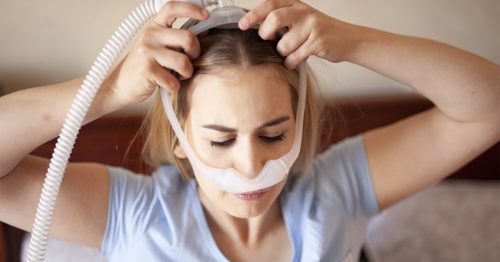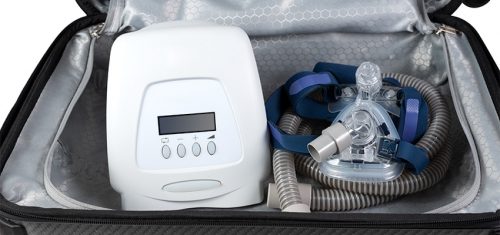How to Put Your Name on a Cpap Report

Continuous positive airway pressure ( CPAP ) is one of the most common treatments for obstructive sleep apnea. The American Thoracic Society reports that obstructive sleep apnea has a worldwide prevalence rate of between 3% and 7%, and is becoming more widespread at this time. Knowing how to properly use your CPAP machine can help you achieve more consistent, quality sleep and reduce symptoms related to your sleep disorder .
Here's a guide to using CPAP , along with tips on how to make your CPAP equipment work as efficiently as possible.
What is CPAP?
CPAP is a device that delivers a continuous stream of airway pressure to keep your airway open and prevent it from collapsing while you sleep. CPAP machines were originally developed during the 1980s to treat people with obstructive sleep apnea , and have evolved over the years to provide a higher level of patient comfort and treatment efficacy. A CPAP device is typically made up of a face mask, tube, and motor.
CPAP headgear is available in the form of a large mask that covers the nose and mouth, or a smaller mask that covers only the nose. Some devices use nasal plugs that fit comfortably into the nostrils instead of a face mask. A CPAP hose or tube connects the mask or nasal plugs to the motor, which blows air into the hose to keep the airway open while you sleep.
How to Use CPAP
Each CPAP machine is slightly different from the next and has its own set of instructions for use and maintenance. Your doctor will show you how to properly use and wear your CPAP equipment , and provide you with detailed instructions.
Installing the CPAP filters is usually the first step in using CPAP , followed by attaching the CPAP hose and mask. The CPAP machine should be placed on a flat, stable surface near your bed, such as a nightstand or dresser. The vents of the machine should be positioned at least 12 inches away from the wall, curtains, and other objects to allow for clean, unobstructed airflow.
When you're ready to go to sleep, you can fit the face mask over your head or insert the nasal plugs, then turn on the machine. The pressure settings should already be set according to the prescription issued by your doctor. Lie back on your pillow and relax, and focus on taking natural, even breaths as the CPAP machine does its work.

Which CPAP Supplies Are Needed?
Most CPAP machines will come with everything you need so you don't have to purchase extra supplies in the beginning. However, as time goes by, you may need to replace some CPAP machine parts and supplies such as the CPAP filters and hose to keep the machine functioning optimally.
CPAP filters should be replaced once every four weeks, or more often if you live with someone who smokes or with pets who shed high amounts of hair. The CPAP hose should be cleaned regularly and replaced once every 12 months to promote good airflow.
Some people choose to replace their CPAP headgear with a more comfortable face mask that fits properly and prevents any air leakage. A study published in the Journal of Thoracic Disease found that patients who experience air leakage or discomfort from wearing CPAP headgear tend to have lower treatment adherence rates; therefore, finding a mask that fits comfortably can go a long way toward improving your sleep apnea symptoms. The UC Berkeley School of Public Health states that a CPAP mask should fit snugly enough to prevent air leakage, but not too tight to the point it causes pain or sores to develop on the face.
Tips for Getting Used to CPAP
Sleeping with CPAP may take some time getting used to, but there are steps you can take to make sure your transition period goes smoothly.
First, wear the CPAP headgear for brief periods during the day while you're relaxing at home to get used to the way it feels on your face. Use CPAP while watching TV, browsing the Internet, or reading a book. You will also want to use CPAP any time you lie down to take a nap.
Next, invest in a set of earplugs to wear while sleeping, or place a piece of foam under the CPAP motor if you think the machine will keep you awake at night. The CPAP machine can serve as an effective source of white noise, though some may be bothered by the new, unfamiliar sound.
Lastly, check to see whether your CPAP machine has a ramp mode feature, and use this setting until you've adjusted to using the device. The ramp mode feature gradually increases the air pressure level as you fall asleep so it doesn't feel as though you're receiving an overwhelming heavy flow of powerful air.
Setting Yourself Up for CPAP Success
If you think you may be suffering from sleep apnea and need CPAP treatment , consider using an at-home sleep test to help your doctor diagnose your sleep condition. A sleep study test and a proper diagnosis from a doctor can bring you one step closer toward improving your sleep hygiene and achieving a quality night's sleep.
- Author
- Recent Posts
Board-certified sleep M.D. physicians, scientists, editors and writers for ASA.

How to Put Your Name on a Cpap Report
Source: https://www.sleepassociation.org/sleep-apnea/cpap-treatment/cpap-user-guide/
0 Response to "How to Put Your Name on a Cpap Report"
Post a Comment